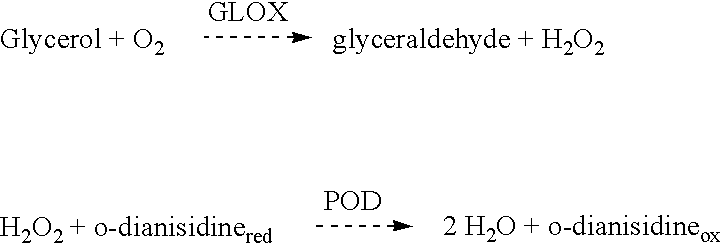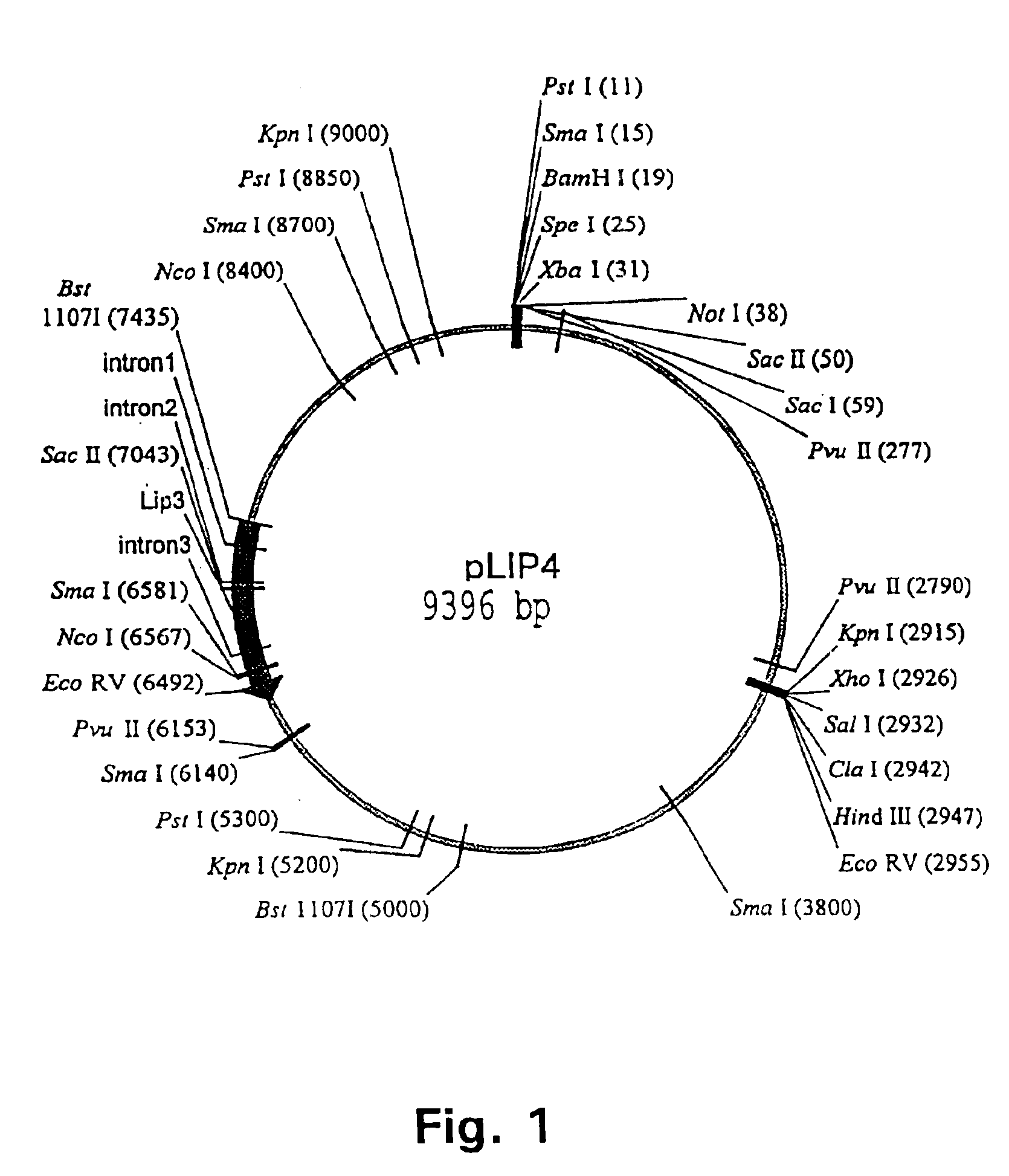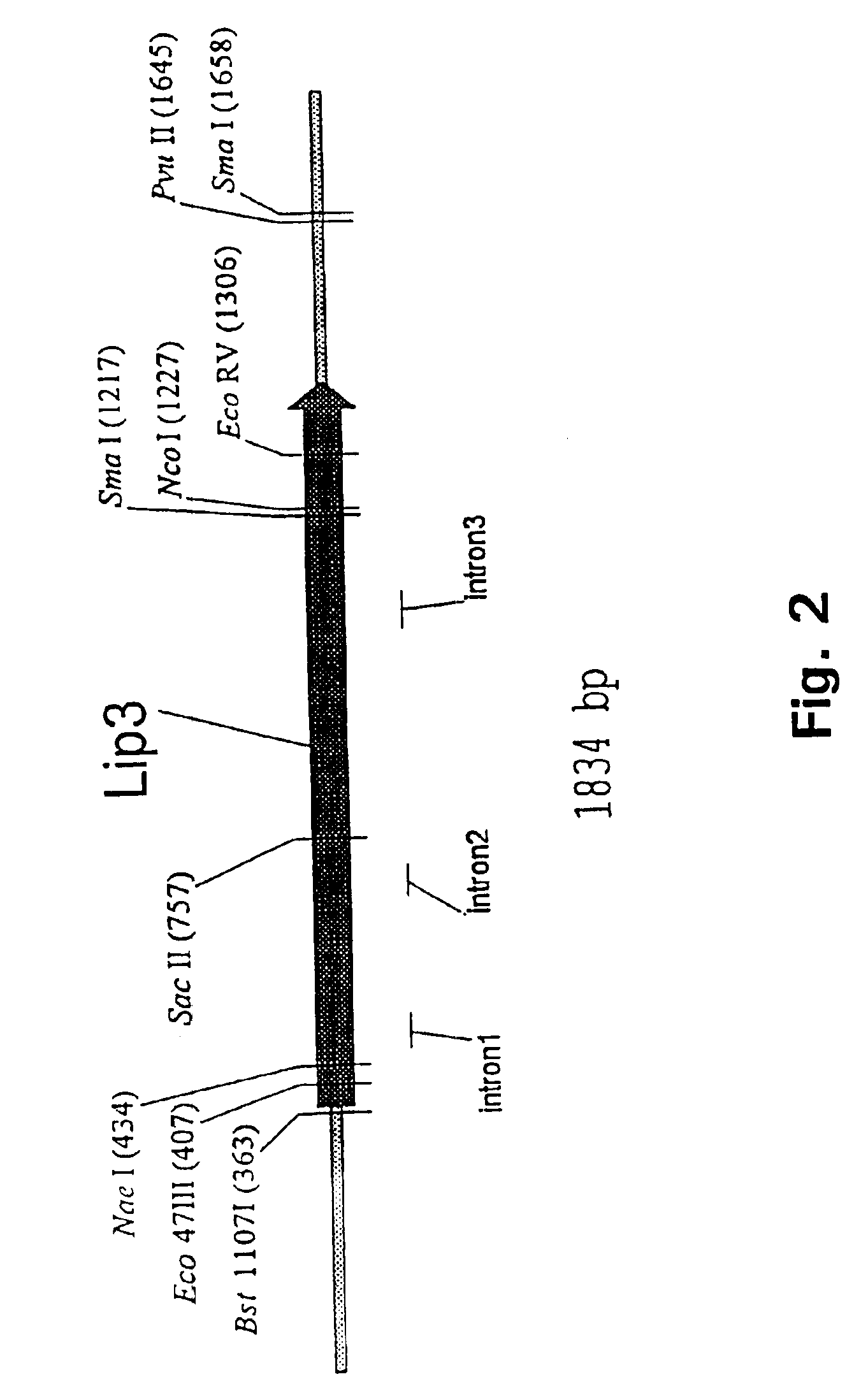Method for preparing flour doughs and products made from such doughs using lipase
a technology of lipase and flour dough, which is applied in the field of lipase-based flour dough preparation methods, can solve the problems of objection or use of several currently available non-specific oxidizing agents, and achieve the effect of enhancing the baking strength and increasing the b/c ratio
- Summary
- Abstract
- Description
- Claims
- Application Information
AI Technical Summary
Benefits of technology
Problems solved by technology
Method used
Image
Examples
example 1
Production, Extraction and Purification of Glycerol Oxidase Using Different Strains and Cultivation Conditions
1. Production, Extraction and Purification of Glycerol Oxidase Using Aspergillus japonicus ATCC 1042 Cultivated in a Production Medium Containing 3% Glycerol
The following assay for determination of glycerol oxidase activity was used:
The assay is based on the method described by Sullivan and Ikawa (Biochimica and Biophysica Acta, 1973, 309:11-22), but modified as described in the following. An assay mixture containing 150 .mu.l 2% glycerol (in 100 mM phosphate buffer, pH 7.0), 120 .mu.l 100 mM phosphate buffer, pH 7.0, 10 .mu.l o-dianisidin dihydrochloride (Sigma D 3252, 3 mg / ml in H.sub.2 O), 10 .mu.l peroxidase (POD) (Sigma P8125, 0.1 mg / ml in 100 mM phosphate buffer, pH 7.0) and 10 .mu.l glycerol oxidase (GLOX) solution. The controls are made by adding buffer in place of GLOX solution. The incubation is started by the addition of glycerol. After 15 minutes of incubation at...
example 2
Production, Purification and Characterization of Lipase 3
2.1. Production
A mutant strain of Aspergillus tubigensis was selected and used for the production of wild type lipase. This lipase is referred to herein as lipase 3. The strain was subjected to a fermentation in a 750 1 fermenter containing 410.0 kg of tap water, 10.8 kg soy flour, 11.1 kg ammonium monohydrogenphosphate, 4.0 kg phosphoric acid (75%), 2.7 kg magnesium sulfate, 10.8 kg sunflower oil and 1.7 kg antifoam 1510. The substrate was heat treated at 121.degree. C. for 45 minutes. The culture media was inoculated directly with 7.5.times.10.sup.9 spores of the mutant strain. The strain was cultivated for three days at 38.degree. C., pH controlled at 6.5, aeration at 290 l / min and stirring at 180 rpm the first two days and at 360 rpm the last day. The fermentate was separated using a drum filter and the culture filtrate was concentrated 3.8 times by ultra-filtration. The concentrated filtrate was preserved with potassium s...
example 3
Amino Acid Sequencing of Lipase 3
Purified lipase enzyme was freeze-dried and 100 .mu.g of the freeze-dried material was dissolved in 50 .mu.l of a mixture of 8 M urea and 0.4 M ammonium hydrogencarbonate, pH 8.4. The dissolved protein was denatured and reduced for 15 minutes at 50.degree. C. following overlay with nitrogen and addition of 5 .mu.l 45 mM dithiothreitol. After cooling to room temperature, 5 .mu.l of 100 mM iodoacetamide was added for the cysteine residues to be derivatized for 15 minutes at room temperature in the dark under nitrogen.
135 .mu.l of water and 5 .mu.g of endoproteinase Lys-C in 5 .mu.l of water was added to the above reaction mixture and the digestion was carried out at 37.degree. C. under nitrogen for 24 hours. The resulting peptides were separated by reverse phase HPLC on a VYDAC C18 column (0.46.times.15 cm; 10 .mu.m; The Separation Group, California, USA) using solvent A: 0.1% TFA in water and solvent B: 0.1% TFA in acetonitrile. Selected peptides were...
PUM
| Property | Measurement | Unit |
|---|---|---|
| temperatures | aaaaa | aaaaa |
| temperatures | aaaaa | aaaaa |
| temperatures | aaaaa | aaaaa |
Abstract
Description
Claims
Application Information
 Login to View More
Login to View More - R&D
- Intellectual Property
- Life Sciences
- Materials
- Tech Scout
- Unparalleled Data Quality
- Higher Quality Content
- 60% Fewer Hallucinations
Browse by: Latest US Patents, China's latest patents, Technical Efficacy Thesaurus, Application Domain, Technology Topic, Popular Technical Reports.
© 2025 PatSnap. All rights reserved.Legal|Privacy policy|Modern Slavery Act Transparency Statement|Sitemap|About US| Contact US: help@patsnap.com



